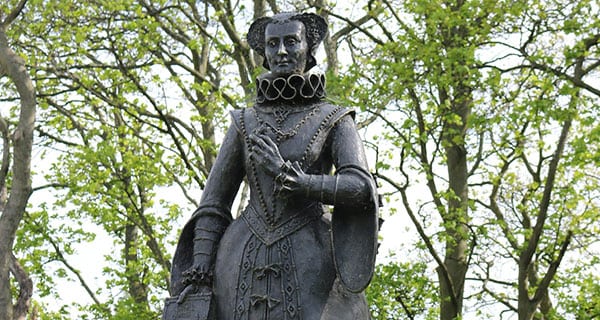 This Christmas, cinema patrons will be offered the historical drama Mary, Queen of Scots. With Saoirse Ronan in the title role and Margot Robbie as Elizabeth I of England, the movie casts two of today’s prominent actresses in a retelling of the 16th century’s most compelling personal rivalry.
This Christmas, cinema patrons will be offered the historical drama Mary, Queen of Scots. With Saoirse Ronan in the title role and Margot Robbie as Elizabeth I of England, the movie casts two of today’s prominent actresses in a retelling of the 16th century’s most compelling personal rivalry.
As the movie is based on John Guy’s sympathetic biography of Mary, My Heart is My Own, we can anticipate her being etched in positive terms.
It hasn’t always been so.
Over the past four-plus centuries, Mary’s reputation has waxed and waned. Often, the opinion dividing line centred on religion – the Catholic Mary versus the Protestant Elizabeth.
To Catholics, Mary was a murdered martyr. To Protestants, she was a scheming adulteress who was complicit in the murder of one husband and conspired to assassinate Elizabeth in order to usurp the English throne.
Born a Stuart in 1542, Mary became Queen of Scotland when her father died a mere six days after her birth. But because of her age, Scotland was ruled by a regency and Mary was dispatched to her French mother’s homeland. There, she married the heir to the throne, served briefly as Queen consort of France and was a childless widow by her 18th birthday.

Mary, Queen of Scots
Martyr or adulteress?
Returning to Scotland in 1561, she found the “gangsterish aristocratic milieu” difficult to navigate. And with the skids greased by two ill-advised Scottish marriages, her position collapsed to the point where she was forced to abdicate in 1567. She escaped to England the following year, only to be confined in various castles until she was eventually beheaded for her role in the Babington Plot to kill Elizabeth.
And it was that gory 1587 execution that bestowed the aura of martyrdom. Let’s just say that the axeman’s aim could have been better.
As Guy tells the story, Mary’s nemesis was the highly unscrupulous William Cecil. Serving as Elizabeth’s chief adviser for most of her reign, Cecil was “out to get Mary.”
Right from her teenage years in France, Cecil saw Mary as “the instigator and main beneficiary of an international Catholic conspiracy to depose and kill Elizabeth.” So he schemed and plotted to have her removed from power and subsequently killed. Skulduggery was his stock in trade.
But while Cecil may have had an apocalyptic view, his sense of a threat to Elizabeth wasn’t entirely fanciful. Far from it.
There were still many Catholics in England, particularly in the north. And to them, Mary wasn’t just a Scottish queen. She also had a plausible claim to the English throne.
As the great-granddaughter of Henry VII – and Elizabeth’s first cousin once removed – Mary had a bona fide Tudor bloodline. And Elizabeth could be, and was, often depicted as the illegitimate daughter of Anne Boleyn.
Compounding the risk, Pope Pius V had issued Regnans in Excelsis in 1570. It declared Elizabeth to be a bastard and a heretic, released her subjects from any allegiance and excommunicated any who obeyed her orders. From the Vatican perspective, it was open hunting season and Catholic European monarchs were encouraged to have a go.
There were also plots against Elizabeth, some real, some exaggerated and perhaps some invented. Whether Mary was complicit is a matter of dispute, except for one situation. Even Guy acknowledges her involvement in the Babington Plot.
One perspective of Guy’s is especially interesting.
Although rivals, he sees Mary and Elizabeth as having something critical in common. They were both royalists, determined defenders of hereditary rights and focused on maintaining monarchical prerogatives. Whimsically, he describes them as “fully-paid-up members of the monarchs’ trade union.”
In contrast, Cecil – the story’s otherwise villain – can be seen as an early proponent of parliamentary sovereignty, someone who believed that “political power lies in the people and not in the ruler.”
It was this disagreement that caused Elizabeth to stall Cecil for so many years. Like her, Mary was an anointed Queen. And although monarchs could be killed in battle or even surreptitiously murdered, the idea of executing one by the official authority of the state was a different matter entirely. Formal regicide could set a dangerous precedent.
For this reason, Guy calls Mary’s execution “the most critical event of the era.” Whether he fully realized it, Cecil was putting the monarchy on probation.
Troy Media columnist Pat Murphy casts a history buff’s eye at the goings-on in our world. Never cynical – well, perhaps just a little bit.
The views, opinions and positions expressed by columnists and contributors are the author’s alone. They do not inherently or expressly reflect the views, opinions and/or positions of our publication. Troy Media is a Troy Media Digital Solutions Associate website.


